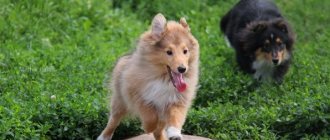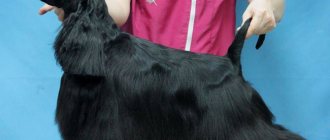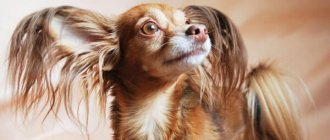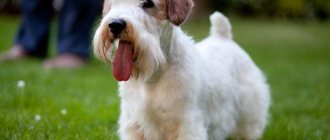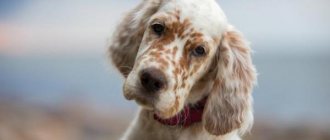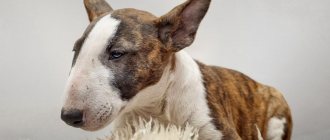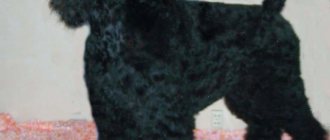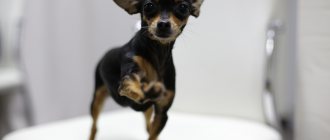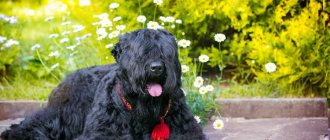Today the breed is called Russian Toy, but for many, the outdated name is more familiar - Russian Toy Terrier. Having gained considerable popularity for its sociable qualities and miniature size, the Toy has become another source of pride for Russian breeders. The fashion for small dogs that can be carried in a bag also played an important role. The Russian Toy has become a rather serious competitor for the Yorkie, since, unlike its “rival”, it has short hair and does not need regular haircuts.
Description of pets
Toy terriers are miniature dogs with a cheerful disposition, love of life and activity.
Exterior
(information in accordance with the breed standard ): :
- eyes - large, slightly convex, round in shape, set wide apart;
- ears - large, erect, high-set, triangular in shape;
- body - strong back, oval chest, slightly sloping, rounded croup;
- limbs are straight, slender, the hind limbs are set wider than the front ones.
Representatives of this breed move quickly, straightforwardly, freely.
Coat
There are two varieties of Russian Toy: smooth-haired and long-haired. Smooth-haired dogs have short, close-fitting, shiny hair without undercoat or bald patches. In long-haired individuals, the body is covered with moderately long (3–5 cm), straight or slightly wavy, close-fitting hair that does not hide the natural contours of the body. The hair on the head and the front side of the limbs is short and close-lying. There are clearly defined feathers on the back of the limbs. All paws also have elongated, silky hair that completely hides the claws. The ears are covered with thick and long hair in the form of a fringe.
Origin story
The ancestors of the breed were English toy terriers , bred in the 19th century. in England by selecting small black and tan hunting terriers and then crossing them with small greyhounds .
Their main purpose was to catch rodents and insects, in which they are somewhat similar to the Prague rat rats, and to entertain children. The name "Toy Terrier" was given to these dogs in the second half of the 20th century.
Russian toy terriers
appeared in the 20th century. in the USSR, when the process of restoring the breed was underway .
Due to the lack of purebred individuals, crossbreds were also taken into work. The resulting puppies were significantly different from their parents, so in 2006 they were officially identified as a separate breed. At first these were only smooth-haired toy terriers, and later long-haired ones also appeared.
American toys
also differ significantly from English ones . When breeding them, they used fox terriers, from which the “Americans” got the white color of the main part of the body and character.
A Brief History of Russian Toys
The breed comes from the English Toys, who had a reputation as unrivaled rat catchers. Toy terrier dogs were brought to Russia during the reign of Peter I and by the middle of the 19th century they managed to gain popularity among the local bourgeoisie. Animals lived in imperial palaces and the chambers of rich ladies, accompanying them to balls and social events.
After the revolution, decorative toys began to be considered “bourgeois excess.” For a long time, salon dogs remained in the shadow of their larger counterparts of service and guard breeds. For almost half a century, they gradually died out and degenerated, interbreeding with local mongrels.
The modern history of the breed began in the USSR in the middle of the 20th century. In the 1950s, Soviet breeders decided to revive the population of decorative toys. True, at that time there were no purebred individuals left in the country. Therefore, enthusiastic breeders had to work with dogs without documents and animals exported from Germany as war trophies.
Due to the fact that at that time the country was pursuing an “Iron Curtain” policy, Soviet breeders did not have the opportunity to compare the resulting livestock with English Toys and for a long time did not realize that they had bred a new breed.
In 1957, an unusual male puppy with furry ears and feathering on his paws was born from a pair of Russian Toys, one of which was not purebred. The breeders really liked him and subsequently became the founder of a branch of long-haired toys. Despite its popularity, the Russian Terrier did not receive recognition from world associations for a long time and was registered in conditional status only in 2006.
Interesting! Translated from French, toy terrier means “dog for holes,” and the English prefix toy indicates its tiny size.
Character traits
Toy terriers are cheerful, sociable and playful dogs . They are distinguished by cheerfulness and energy, they quickly become the center of attention and a source of positivity.
Friendly Toy Terriers get along well with other pets as long as they do not show aggression, and they easily get along with children due to their curiosity and love of games.
However, it is better not to buy a dog of this breed for families with children under 5-6 years old, as they can accidentally injure the pet during play.
Toys are infinitely devoted to their owner, they need their attention and care . Dogs have difficulty withstanding loneliness, which becomes a source of stress and a cause of aggressive behavior.
Toy terriers are fearless guards, unaware of their own compact size, capable of bravely rushing into a fight even with much larger dogs if they feel that their owner is in danger.
Expert opinion
Kozhevin Semyon Kirillovich
Expert dog handler.
Many people love toy terriers precisely for their miniature size, but at the same time this is also a minus of the breed, since dogs, especially puppies, are very susceptible to injury. Also, most owners note the friendliness and lack of aggression in toy dogs, but it is worth noting that this is only possible with proper upbringing. In general, this breed is suitable for almost everyone, even those who have not dealt with dogs before. The only exceptions are people who lead a measured lifestyle - the irrepressible energy of the toy is not combined with calmness, constant silence and monotony.
How to accustom a toy terrier to a diaper or tray
The toilet tray will become a lifesaver for the owners of a miniature toy. Unlike large breed dogs, these babies do not need to be taken outside regularly. The tray will eliminate this need if the weather outside is frosty, or you simply don’t want to get out from under the blanket early on a day off.
“Of course, you need to walk the dog,” says breeder Olga Moskaleva. “But a tray in the house wouldn’t hurt either.” It solves the problem of walking when you can't. The breeder must train him to use the tray. We hand over our puppies to owners who are already trained and understand what a litter box is and what it is needed for.”
If your baby does not yet know the purpose of the tray, teach him to use the toilet from the first minutes of his stay in the house. Once you bring it home, place it on the tray and praise if the baby used it correctly. When you are at home, keep an eye on the puppy and take him to the tray if you notice that he is restless or looking for something. Always praise for successful use of the toilet and give your baby a treat. Toys are smart dogs, they quickly remember why they receive praise, and try to please their owner again and again.
Advantages and disadvantages
Toy terriers are small dogs, ideal for living in city, even small, apartments.
In addition, they have a number of other advantages:
- courage;
- mind;
- loyalty;
- good health;
- the ability to train to a tray or diaper;
- pretty appearance;
- friendliness;
- unpretentiousness.
Along with their advantages, toy terriers also have some disadvantages.:
- stubbornness;
- loud barking;
- aggression and uncontrollable behavior due to improper upbringing;
- large tremors when overexcited;
- intolerance of loneliness;
- tendency to allergies;
- fragile skeleton.
Also, representatives of this breed are sensitive to temperature changes and cannot tolerate cold.
Training
Toy terriers are very stubborn, so they are quite difficult to train.
There are some features in their upbringing:
- The dog should not be allowed to growl. The growling is stopped immediately by a command given in a loud voice.
- The owner always enters the door first. So it’s worth slowing down the dog’s leadership instinct.
- You should not allow a toy terrier into your bed. He should have his own soft and cozy place, which should be accustomed to immediately through the “place” command.
- If you travel frequently, you should train your dog to travel in a special bag. It is also worth accustoming to ordinary, standard commands. They may not be needed, but they will definitely teach the dog discipline.
Main types
The table shows the main varieties of toy terriers and their descriptions:
| View | Description |
| Russian toy terrier | The breed was recognized by the FCI in 2006. Modern Moscow Toys are small, long-legged dogs with a small apple-shaped head, a dry, elongated muzzle, large bulging eyes, high-set triangular ears and a high-set tail. Height at the withers is 20-26 cm, weight 2-3 kg. There are 2 varieties: long-haired and smooth-haired |
| English toy terrier | Elegant dogs, 25-30 cm tall and weighing 2.7-3.6 kg. They have a narrow muzzle, an elongated skull, and erect ears. The coat is thick, short, and fits tightly to the body. Only black and tan color allowed |
| American Toy Terrier | A breed still unrecognized by the FCI. When breeding, they used smooth fox terriers, English toy terriers and Chihuahuas. The height of these dogs is 24-25 cm, weight - 1.5-3.5 kg. They have a small head, large triangular erect ears, a short tail and a shiny coat, colored in 2 or 3 colors: white with black and (or) red spots on the head and rump |
Breed characteristics
- Aggressiveness: Low ( Overall score
2/5) - Activity: Average ( Overall score
3/5) - Training: Average ( Overall score
3/5) - Shedding: Low ( Overall score
2/5) - Need for care: Medium ( Overall score
3/5) - Friendliness: Friendly ( Overall score
4/5) - Health: Average ( Overall score
3/5) - Maintenance cost: Low ( Overall score
2/5) - Attitude towards loneliness: Short periods ( Total score
2/5) - Intelligence: Standard ( Total score
3/5) - Noise: Above Average ( Overall
4/5) - Security qualities: Average ( Overall score
3/5)
Color variations
There are several coat color options for Toy Terriers.:
- black and tan - the black color should not have any shades, the tan is on the face, ears, chest and near the temples;
- sable - toi with red hairs at the roots and black at the ends;
- chocolate, brown and red - most often found in Russian Toy Terriers, these colors are difficult to preserve in offspring;
- blue and purple - arise as a result of the activity of a recessive gene;
- fawn - acceptable options are from light red to milky white;
- isabella - a color derived from lilac, rare;
- white - such dogs are attractive in appearance, but cannot participate in exhibitions and breeding.
The variety of colors is explained by the fact that 2 pigments and 10 genes are involved in their formation.
Animal nutrition
Toy terriers can be fed with ready-made dry food or natural products, the main thing is to keep the diet balanced and not mix both types of feeding.
A natural menu should contain:
- lean meat;
- buckwheat, oatmeal, rice porridge;
- vegetables and fruits;
- low-fat cottage cheese, kefir;
- sea fish;
- boiled egg yolk.
You cannot feed a toy terrier :
- fatty and smoked products;
- sweets and pickles;
- sausages and flour products;
- river fish;
- potatoes, legumes.
Among dry food, preference should be given to premium or super premium products, which contain all the necessary micro- and macroelements.
The most popular foods are products from the brands Acana, Orijen, Canidae, Hills, Eukanuba, Purina, Royal Canin.
How to stop barking and biting?
First of all, you should find out the reasons for this behavior.
There are only two of them:
- Playfulness.
- Dominance.
In the first case, the dog does not bite on purpose, during play.
Just stop playing if the baby is too carried away and strictly say “no” . It would be enough.
If the reason is dominance, this means that the dog considers himself in charge. Be firm, behave confidently, apply sanctions and do not allow your pet unnecessary things.
As punishment, you can deprive your pet of games, treats, or ignore.
Health and life expectancy
Most Toy Terrier diseases are hereditary or result from improper care.
Most often these dogs are diagnosed:
- fractures and dislocations;
- vertebral displacement;
- dental problems - stones, plaque, disruption of the replacement of milk teeth by molars;
- conjunctivitis;
- glaucoma;
- cataract;
- retinal atrophy;
- otitis;
- increased intracranial pressure;
- breathing problems;
- diarrhea;
- vomiting;
- hydrocephalus;
- epilepsy;
- diseases of the cardiovascular system;
- diabetes;
- obesity;
- allergies;
- hind leg failure.
To prevent diseases, it is necessary to follow a diet and monitor its balance and nutritional value, carry out deworming and treatment for external parasites, and regularly undergo routine examinations by a veterinarian.
With proper care and proper living conditions, the life expectancy of toy terriers is on average 12-15 years .
Dimensions and weight
A standard representative of the breed weighs about 1 kg at 2.5 months, and approximately 1.5 kg at 3-4 months. An adult dog grows to 20-27 cm at the withers and reaches a maximum weight of 3 kg.
Read more detailed information about the size of toy terriers here.
NOTE!
Mini Toy Terriers weigh about 600-800 g at 2-3 months and 1.5-1.6 kg when full grown.
Miniature representatives of the breed more often have pathologies and developmental defects.
Dossier
Adult height: from 20 to 28 cm. Weight: no more than 3 kg. Characteristic color: brown, red, blue and tan. Coat length: longhaired. Life expectancy: up to 18 years. Advantages of the breed: compact, cheerful, loves to spend time in the company of the owner. Difficulties of the breed: susceptible to stress, loves to voice. Average price: up to $200 for a regular puppy; $500 for a puppy with a pedigree. Classification: small breed; companion dog.
Education and training
Without proper education and training, toy terriers grow up to be uncontrollable dogs that consider themselves to be the main ones in the family.
These dogs are smart and have a good memory, so instill in them the rules of behavior in the house and teach them the basic commands “Fu!”, “Come to me!”, “Sit!” not difficult .
You need to start training from early childhood, immediately after the puppy remembers its name.
Toy terriers are cunning and constantly try to avoid following commands, so it is necessary to develop rules and stick to them.
Classes should be regular, commands should be given in a calm but confident tone, the owner needs patience and perseverance. You cannot physically punish your pet .
Celebrities and their people
Thanks to its exceptionally pleasant internal qualities, the Toy Terrier has gained wide popularity not only among ordinary citizens, but also among celebrities. Sergey Lazarev, Alla Pugacheva, Sergey Zverev, Diana Gurtskaya, Garik Kharlamov, Lyudmila Gurchenko, Christina Aguilera can boast of friendship with Russian Toychiks. The Russian Toy Terrier is an amazing dog. She feels equally comfortable in a star penthouse and in an ordinary apartment. The ability to enjoy life, sociability, and devotion make the Russian Toy the favorite of any person - from the president to the housewife. The main thing that is required of you is to give love and receive even more in return.
return to section
What to feed toy terriers? The right diet
Small breed dogs eat little, but often, and toy terriers are no exception. But what foods should prevail in their diet? Can I feed only dry food or will I need to select natural products? What is the difference between the diet for puppies and adult dogs of this breed? Let's figure it out. Now you will learn how and what to feed your toy terrier.
Wisdom of feeding toy terriers
Toy terriers are miniature, energetic and cute dogs that easily get along with people and are friendly and cheerful. But so that the baby feels good, does not get sick and pleases others with his well-groomed and healthy appearance
If you are planning to buy a Toy Terrier in Moscow, then you should know what kind of puppy a puppy should be, what documents it should have, and also where is the best place to buy a Russian Toy puppy. This small but useful article about small domestically bred dogs will help you figure this out.
Breed characteristics of the Russian Toy. Standards.
Modern Russian Toy Terriers are very small, preferably with a height at the withers of 18 - 26 cm (maximum 28 cm), elegant, agile dogs with high legs, having a square format, thin bones and lean muscles.
Caring for the Russian Toy Terrier
So, your family has been expanded with a little friend. Now you have a small dog - a Russian toy terrier. And of course, your first concern is how to properly care for your beloved toy or cat. Grooming a small dog is not very difficult (with the possible exception of Yorkies), but it still requires certain skills and knowledge. Let's look at everything in detail.
Dog care
The table contains the main points for caring for toy terriers :
| Part of the body | Care |
| Wool | Short-haired toy terriers should be combed every 7-14 days, more often during the shedding period; Long-haired representatives of the breed need to be combed daily, and they also need to have their coat trimmed periodically. Washing is required once a quarter using shampoo appropriate for the coat type. |
| Eyes | Wipe daily with a cotton pad soaked in warm water or chamomile infusion. |
| Teeth | Clean every 7 days with a special paste and brush |
| Ears | Inspect regularly and clean monthly |
| Claws | Once a month you need to trim with a nail clipper and file to avoid delamination. |
Care and maintenance
The small Russian Toy Terrier dogs do not have an undercoat and do not tolerate cold weather well. Therefore, representatives of the breed cannot be housed outdoors, even if there is an insulated booth. Caring for them is simple and comes down to basic hygiene, proper feeding and timely veterinary care.
The right diet
You can feed the Russian Toy with both industrial and natural food. With the first option, owners have less trouble and there is no fear that the pet will not receive enough nutrients.
The main thing is to choose a high-quality super-premium or holistic food for miniature breeds, which does not contain any questionable ingredients such as soy, corn or dyes.
You can find out in detail how to feed your pet correctly in the article “Nutrition of the Russian Toy Terrier.”
Products of the following brands best meet the stated requirements:
- Brit Care;
- Royal Canin;
- Grandorf;
- Hills.
With a natural type of feeding, 60-70% of the total diet should come from lean meat such as chicken, beef or turkey. Before giving the meat to the dog, it is kept in the freezer for several days, cut into pieces and scalded with boiling water.
Also included in the diet of the Russian Toy Terrier:
- eggs;
- fish;
- cereals;
- vegetables;
- offal;
- dairy products.
In order for a dog of this breed not to be fat and to remain healthy and active longer, pickles, smoked meats, river fish, tubular bones, sausages and confectionery products, mushrooms, legumes, onions and any food from the owner’s table are forever excluded from its menu.
Walking and physical activity
Despite its fragile build and tiny size, the small Russian Toy Terrier needs regular time in the fresh air. An active lifestyle and moderate exercise will help a dog of this breed maintain muscle tone and prevent the development of obesity.
On a note. The Russian Toy Terrier dog breed is prone to injuries. Therefore, during walks, pets need to be protected from jumping, falling and contact with larger brothers.
Due to the lack of undercoat, the Russian Toy Terrier is susceptible to sudden temperature changes and does not tolerate dampness. Therefore, in cold or rainy weather, walking your dog should be kept to a minimum. And before leaving the house, your Russian Toy Terrier should be dressed in warm, waterproof overalls.
Read about how to choose clothes for a Russian Toy.
Training and education
The Russian Toy Terrier is quite trainable. But, like other small breeds of dogs, he skillfully uses his cuteness, and if the owner gives in, he can feel permissiveness and turn into a real tyrant. Therefore, raising a pet needs to be done from the first days of its appearance in the house. As soon as the toy terrier puppy adapts to new conditions, they begin to accustom him to a certain routine and adherence to established rules.
In order not to spoil the baby, he is forbidden from the very beginning:
- bark for no reason;
- bite;
- beg;
- jump on people;
- damage property;
- sleep on upholstered furniture.
In order for an adult Russian Toy Terrier to respond adequately to various stimuli, it is socialized from puppyhood. For this purpose, the baby is often walked in busy places and introduced to strangers and other animals.
For comfortable living together, the Russian Toy Terrier should be taught basic commands. It is desirable that by the age of 12 months the dog should be able to:
- walk nearby on a leash;
- return to the owner at the first call;
- follow the commands “Sit!”, “Place!”, “Ugh!” and “Stop!”
Hygiene
In order for the Russian Toy to look neat, he is provided with proper care:
- The dog's eyes and ears are regularly wiped with a cotton swab moistened with herbal decoction or boiled water. They are also examined for the presence of unusual discharge. If pus or redness is detected, the animal is shown to the veterinarian.
- The claws of the Russian Toy are shortened twice a month with a nail cutter, trying not to affect living tissue.
- The dog's teeth are cleaned 2-3 times a week with a special paste applied to a soft brush or silicone attachment.
- The short-haired and shaggy toy terriers require different grooming. A smooth-haired dog is bathed once a month and brushed weekly with a special glove. The fluffy toy terrier is more demanding in terms of grooming. The shaggy dog is brushed daily and bathed twice a month. Also, the hairy toy terrier needs regular haircuts.
Vaccinations and susceptibility to disease
The Russian Toy has good heredity and relatively good health. But due to the structural features of the skeleton and eyes, the breed has a predisposition to the following pathologies:
- instability of the cervical vertebra;
- necrosis of the femoral head;
- dislocated knee;
- hypoglycemia;
- hydrocephalus;
- retinal atrophy;
- cataract.
To protect your dog from viral and infectious diseases, it is regularly vaccinated against rabies, distemper, leptospirosis and enteritis. The first vaccination is carried out at the age of 8-9 weeks and repeated after 21 days. Subsequently, the large toy terrier is vaccinated once a year.
Important! Before routine vaccination, the dog must be subjected to antiparasitic treatment.
Lifespan
The Toy Terrier breed belongs to the long-living category. The average lifespan of these dogs is 12-15 years.
Breeding principles
There are several factors to consider before breeding a Toy Terrier.:
- dog class - representatives of the pet class cannot participate in breeding;
- size - for dogs below 20 cm and weighing less than 1.5 kg, pregnancy and childbirth are dangerous;
- coat length—short-haired Toys cannot be crossed with long-haired Toys.
CAREFULLY!
The wrong choice of partners leads to the birth of a litter with various pathologies.
Before the first mating, the bitch must go through at least 3 heats. Most often, 1 to 3 puppies are born in a litter.
If the Toy owner does not plan to breed his dog, then perhaps he should think about sterilization. This will help avoid some of the inconveniences associated with estrus or hunting for females.
Russian Toy: character, training features
Terrier is a class of hunting burrowing dogs, as well as a species bred to fight rodents. The goal of breeding dogs of the Russian Toy Terrier breed
, there was constant accompaniment of the owner as a companion. Due to the crossing of dogs of different temperaments, the Russian Toy acquired all the standard qualities of a pet. An extremely devoted dog to its owner, it gets along harmoniously with all family members. He is wary of strangers, may show aggression or exhibit obvious guard qualities.
The playful and active dog has a rather tough disposition. Owners who do not take their pet seriously risk raising an aggressive dog. At the other extreme are hysterical and cowardly dogs; the cause may be heredity or fear. If the puppy shows a tendency to attack, or excessive excitability, it is worth taking the time to train the pet.
Every dog needs training. Dog training is primarily aimed at adapting the pet to society. Immediately after purchasing a puppy, after waiting a few days for adaptation, you should accustom the dog to basic training. The dog is taught basic rules of behavior from the first days, which makes training easier in the future. Considering the activity of your pet, you should not start training right away. Before the exercises, you need to play, let the dog run around and throw out emotions. Work with your puppy in a calm, quiet environment, without raising your tone. The duration of classes should not exceed 20 minutes, and the first classes are limited to five minutes. As soon as the dog begins to get distracted, fidget, and turn its head, the activity should be stopped and switched to play.
The Toy's character has one more feature: the dog is not aware of its size. Not understanding the balance of their strength with their blood brothers, I, especially males, can behave defiantly with larger dogs. This behavior applies to both games and showdowns, struggles for territory and females. Choose your walking company carefully to avoid fright or injury.
Nicknames for boys and girls
Nicknames given to purebred dogs in kennels in accordance with the rules of the RKF are most often long and difficult to pronounce, so owners give their pets other, “home” names . What it will be like depends only on the owner’s imagination.
| Floor | Nickname |
| Male | Male Adam, Alf, Archie, Barney, Bruno, Wally, Hector, Darcy, Sunset, Casper, Conti, Lord, Max, Nikki, Nor, Oscar, Pierce, Rally, Sapphire, Torrey, Fant, Harvey, Chuck, Charlie, Chance , Elton, Janis, Nolik, Baby, Funtik |
| Bitch | Bitch Iris, Agness, Aika, Bunny, Bessie, Beta, Vivien, Gabi, Gerda, Daina, Dakota, Daphne, Debbie, Dolly, Eva, Jasmine, Zarya, Zateya, Zlata, Country, Karin, Maggie, Nadine, Oxy, Penny , Pinky, Ruby, Sophie, Phoebe, Elsa |
Dogs remember short, sonorous nicknames better. It’s good if they contain the letters “P” or “S”.
Learning ability
It is quite easy to learn. The most common mistake that owners of this breed make when raising them is the desire to isolate the dog in an apartment. With such content, they will be completely deprived of the joy of communicating with the outside world, other people and animals. Of course, normal formation of the dog’s psyche is impossible in this case.
The absence of aggression towards strangers makes it possible to normally help decorative dogs in such sometimes difficult procedures as mating and childbirth. A calm attitude towards attention to oneself is extremely necessary for dogs who are going to attend exhibitions. After all, there inevitably completely strangers will climb into the dog’s mouth and feel various parts of the body. Toy can be taught many tricks: dancing, “singing” to music, tumbling. And the dog may like all this.
Types of crossbreeds
Mixed breeds are dogs born as a result of mating representatives of two different breeds.
Toy Terriers are most often crossed with:
- Yorkshire terriers;
- dachshunds;
- Maltese dogs;
- Pekingese;
- chihuahua;
- Spitz;
- Jack Russell Terriers;
- miniature pinschers.
Also read about the comparison between the Pinscher and the Toy Terrier.
Toy terrier mixes
are not officially recognized by any canine association .
How to choose?
It is important to carefully examine the puppy.
In a healthy baby that meets the breed standard:
- long straight limbs;
- deep chest;
- a pronounced transition from the chest to the abdomen;
- square body;
- body length corresponds to height at withers;
- a small white spot is allowed on the chest or paw;
- the back is straight;
- wool without receding hairline or bald spots;
- eyes and ears are clean.
The puppy should be active and curious, and not try to hide.
Don't worry if your little puppy's ears aren't standing yet - they should be standing by 4 months. Also, most often this breed does not require ear cropping.
What time do toy terrier ears stand up?
Your pet's ears are another indicator of health that you need to pay attention to. In the first weeks of life they can “lie down”, but as they grow older they must rise. This happens because the ear cartilage, initially very thin and soft, becomes stronger. For some babies this happens at two months, for others at four. ears up to six months. But if this did not happen, or the ears “fell”, you need to figure out why.
The first reason is an unbalanced diet. If a dog is fed a “natural diet,” it may lack calcium, resulting in weak cartilage tissue.
The second reason is heredity. If the puppy was not purchased from a nursery or from, there is a high probability that there are “gaps” in its pedigree. Ears may droop if there were many long-haired ones in the family of the smooth-haired toy. Genetic abnormalities cannot be changed either by diet or by trying to “adjust” the dog’s ears.
Of course, you won't stop loving a puppy for its drooping ears. But this will block the way to exhibitions, since it does not fit into the breed standards.
from the personal archive / Olga Moskaleva
